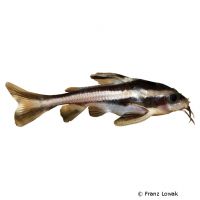Striped Raphael Catfish (Platydoras costatus)
| Striped Raphael Catfish Platydoras costatus | |
|---|---|
| Name | Striped Raphael Catfish |
| Name Lat. | Platydoras costatus |
| Family | Thorny Catfishes |
| Family lat. | Doradidae |
| Order | Catfishes |
| Order lat. | Siluriformes |
| Origin | South America |
| Habitat | Rivers, streams, ponds |
| Diet | Omnivore |
| pH | 6.0-7.5 |
| Behavior | Nocturnal, peaceful |
| Keeping | Individual, group |
| Care Level | Moderate |
| Reproduction | Substrate spawner |
| Breeding | None reported |
| Life Span | 8-12 years |
| Protection | No |
| Metric Units | |
| Size | 20 cm |
| Temperature | 22-28 °C |
| Hardness | 2-15 °dH |
| Aquarium | ~ 300 l |
| US Units | |
| Size | 8" |
| Temperature | 72-82 °F |
| Hardness | 36-267 ppm |
| Aquarium | ~ 80 gal |
Distribution and habitat
Linedorn Catfish are widely distributed in the upper Amazon River basin in Peru. They occur in various habitats, prefer weakly flowing waters and during the day are usually hidden among plants, roots and stones or burrowed in the bottom.
Maintenance
The aquarium should have dense marginal planting, with many hiding places, such as stone caves (e.g. perforated rock) and roots, as well as free sandy areas. A soft, sandy substrate, subdued light (e.g. floating plant cover) and a weak current is ideal
No ammonia, ammonium and nitrite should be detectable, the nitrate value should not exceed 100 mg/l. To ensure the water quality and oxygen content, a filter and heater adapted to the aquarium size is required, as well as lighting for the species-appropriate day-night rhythm of the animals.
Diet
They are omnivores and unproblematic in feeding. The food supply consists of live, frozen and dry food. For a balanced diet, feed at least once a day with a high-quality sinking dry food for catfish (food tablets, granules, pellets) as well as cyclops, daphnia, artemia and mosquito larvae (live or frozen) In addition, they also need vegetable food, such as algae leaves or dry food with high vegetable content.
Only feed as much as will be eaten overnight. Regular and varied feeding promotes health and prevents deficiency symptoms
Behaviour and compatibility
These crepuscular to nocturnal fish are very peaceful and should be kept in a group of 3-5 animals. Keeping a group is only recommended in a larger and well structured aquarium. They can be socialized well with other calm and peaceful fish. Fish that are too small are considered food.
Basically, only compatible fish species with similar demands on water quality and water temperature should be socialized.
Sex dimorphism
No external distinguishing characteristics are known. Females appear somewhat rounder.
Reproduction and breeding
There are no known reports of successful breeding in the aquarium.
Important
They rummage through the substrate in search of food
With their shoulder girdle they can produce creaking sounds.
When catching them, use fine-meshed nets if possible; transparent cups are better so that the hard rays (with barbs) of the pectoral and dorsal fins do not get caught, which can cause painful stinging injuries when touched
The well-being of the fish should be checked regularly. Temperature should be checked daily, pH, hardness and nitrate levels at least every 14 days. Regular partial water changes are recommended, even when contaminant levels have not yet reached the upper limit. Sudden changes in water quality should be avoided. Newly introduced fish must be accustomed slowly to the water in the aquarium.
Further literature can be found in your pet store.
References
Text: Werner Winter; Image: Franz Lowak
Source: BMELV (1998): Tierschutzgutachten - Haltung von Zierfischen (Süßwasser); RIEHL & BAENSCH (2006): Aquarien Atlas Bd. 1, Mergus Verlag; ENGELMANN (2005): Zootierhaltung - Tiere in menschlicher Obhut: Fische, Verlag Harri Deutsch
- Gemäß § 21 Abs. 5 Tierschutzgesetz idgF
